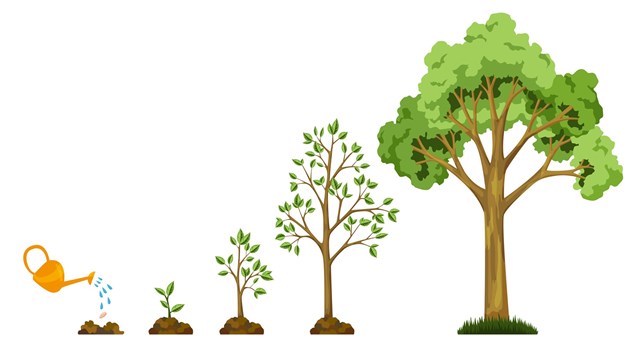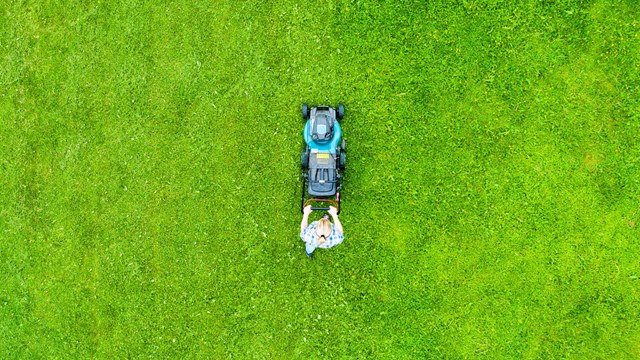Spring is certainly the time to cast off the debris and damage left by the harsh winter months—it's time to take advantage of the warmer weather and cut and edge the grass, rev up the weed whackers, and hone the hedge clippers.
For some properties, this quick spring cleanup may not be enough. Years of wear and tear may have left some properties with ailing azaleas and sad, scraggly trees that even Charlie Brown would have little sympathy for. To get the property back into pristine condition, it might be time to hire a professional for an extreme landscaping makeover.
Green Grass is Curb Appeal
Unfortunately, in today's tight fiscal times with the rising cost of heating oil and other operating costs, landscape rejuvenation may not exactly be at the top of your association's to-do list. Many boards do not consider scenery as part of the property's essentials—certainly not as important as elements such as the roof, windows, and electrical wiring, for example.
Just recently, Alan Milstein, chief operating officer of Live Oak Landscape Contractors in Piscataway, told one association that the approximate cost of the much-needed renovation of their 10 acres of land would be a cool $2 million dollars. Perhaps unsurprisingly, the association balked.
"I've rarely seen an association invest in an entirely new landscape design," says Milstein. "They tend to opt instead for making repairs where and when it's needed. For many associations it's all about the money. They don't understand that the landscape is the first thing that people see. They don't say 'Look at the pretty roof,' or 'Wow, look at the gutters.' Curb appeal is important to the resale of apartments or units, and it makes the non-selling residents feel good and encourages them to stay."
Although it's a major investment, creating a new and improved beautiful landscape isn't just about pleasing the eye; a good first impression can even enhance your association's bottom line.
According to the American Nursery & Landscape Association (ANLA), landscaping can add between seven and 15 percent to a home's resale value. The International Society of Arboriculture's (ISA) website also explains that one economic benefit of trees is directly associated with energy costs—in warmer months, air-conditioning costs are lower in a tree-shaded home, and in the winter, heating costs are reduced when a home has trees that serve as barriers or windbreaks.
The (ANLA) suggests planting evergreen trees to serve as windbreaks on the west or north side of a house, approximately 50 feet (15 meters) or more from the house. On the other hand, deciduous trees (those that drop their leaves in the fall) are beneficial on the south and/or west side of the house to cool in the summer and allow sun to enter the house in the winter.
If a property has been home to the same plants and trees for several years, it just may be time for a change. Just like people transform as they age, so does flora.
"Over a period of years the environment changes," says Sheldon DuBrow, a landscape architect, and the president of DuBrow's Nurseries in Livingston. "The tree canopy gets more dense, the sunny areas become more shaded, and that changes the palate of plants that you would use. The selection of trees we use today is much smaller than what we used years ago."
Planting the Thought
If your association is ready to commit to a complete landscape makeover—or perhaps just needs some assistance in creating an affordable landscape design—there's one step to take before all others. You need to secure the help of a landscape architect who is experienced in multi-unit residential design.
According to the American Society of Landscape Architects (ASLA), landscape architecture encompasses the analysis, planning, design, management, and stewardship of both natural and built environments. Landscape architects have advanced education and professional training and are licensed in 47 states. According to the New Jersey Division of Consumer Affairs, each person applying for landscape architect certification must furnish evidence that he or she is of good moral character and meets the educational and experiential requirements of the division's board. The division website also includes a search engine to check on the references of licensed professionals.
"A certified landscape architect also comes with a certain level of experience on the engineering side," says Milstein.
The landscape architect will delve into the association's wants and needs, while keeping the community's budget clearly in mind.
"Budget is the first consideration," says Brian Hatfield, president of By Design Landscapes, Inc., in Lakewood.
Initial consultation fees vary, but the costs of the project itself will depend on the extent of the makeover and the size of the property. Designs can be scaled down to meet budget needs when necessary.
The Right Stuff
In addition to budgeting, selecting the right trees and plants will depend on several factors—soil conditions, exposure to sun and wind, human traffic, drainage and space constraints.
Landscaping companies will test soil for alkalinity or acidity and will offer recommendations on ways to improve poor soil conditions with fertilizer, sand, peat moss or manure. Poor soil conditions can actually prevent adequate growth and survival.
"The one main objective I have working with an association is to look at the topography of the land and see what trees are suitable," says Hatfield. He adds that there can be many variables—including the intrusion of deer and other animals, whether the land is shaded or sunny, the proximity of the property to the street, and the area's weather.
When designing a landscape, DuBrow says it's not as much about designing for the climate as it is designing for exposure. "If the property gets sun, shade or wind, it determines what kind of plants you should use," he says. "If you are exposed to the ocean and salt air, you need to take that into consideration."
Putting the wrong plant or tree in the wrong growing space can actually be detrimental to the plant. For example, planting tall-growing trees near or underneath utility poles can be extremely dangerous. Pruning tall-growing trees with the intent of maintaining safe clearance can lead to an unnatural appearance, a shortened life span and susceptibility to disease and insects.
When designing in and around parking lots, snow removal is another concern. Pushing snow into landscaped areas can cause severe damage. Pools can also create additional challenges, since they tend to be high-traffic areas.
"Generally, there is one walkway in and it's usually not wide enough," says Milstein. "People cut corners and walk over the grass and near the flowers. The easiest solution would be to make the entrance wider, or to create a secondary access. This is all part of the design process."
According to the ISA, the top five causes of tree death are all results of things people do: soil compaction, underwatering, overwatering, vandalism, and the number one cause—planting the wrong tree—account for more tree deaths than all insect and disease-related tree deaths combined.
How Much—and How Much Care?
Designing a landscaping scheme from scratch or even overhauling what your association already has can represent a significant financial investment. Therefore, it's important to know what you're getting, and how it should be cared for.
According to Milstein, landscape architects bill for approximately $125 per hour, and certified landscape architects charge closer to $185. "The amount you spend depends on what size job you have," he says. "You can spend as little as $1,200, but that's usually for just one homeowner, and not too much. A small development of four or five acres could cost $2,500 just for the design alone."
As for the big projects, like re-designs and landscaping overhauls, Milstein says that if you had 15 acres of turf and nine acres of plant material on your association's grounds, your association might expect to spend at least $750,000 to rip it all out and plant new flowers, bushes, and shrubbery. And that doesn't even include trees.
Given the cost of design and maintenance alone, it's imperative recognize that when choosing plants and trees, the level of maintenance required by different species should also be a serious consideration.
"The landscape lasts longer if it's property maintained," says DuBrow. "Some plants and trees may require less maintenance and can be an affordable alternative to more exotic or expensive varieties."
Most companies charge one fee for an analysis and design and another fee for the actual project. They also recommend that associations take a proactive role in designing their own individual look.
"Every community should have its own personality," says Milstein. "The association's clubhouses and front entrances should also be considered. Look for flowers that fit the style of home and matches the area that you're in."
Lisa Iannucci is a freelance writer and frequent contributor to The New Jersey Cooperator.






Leave a Comment